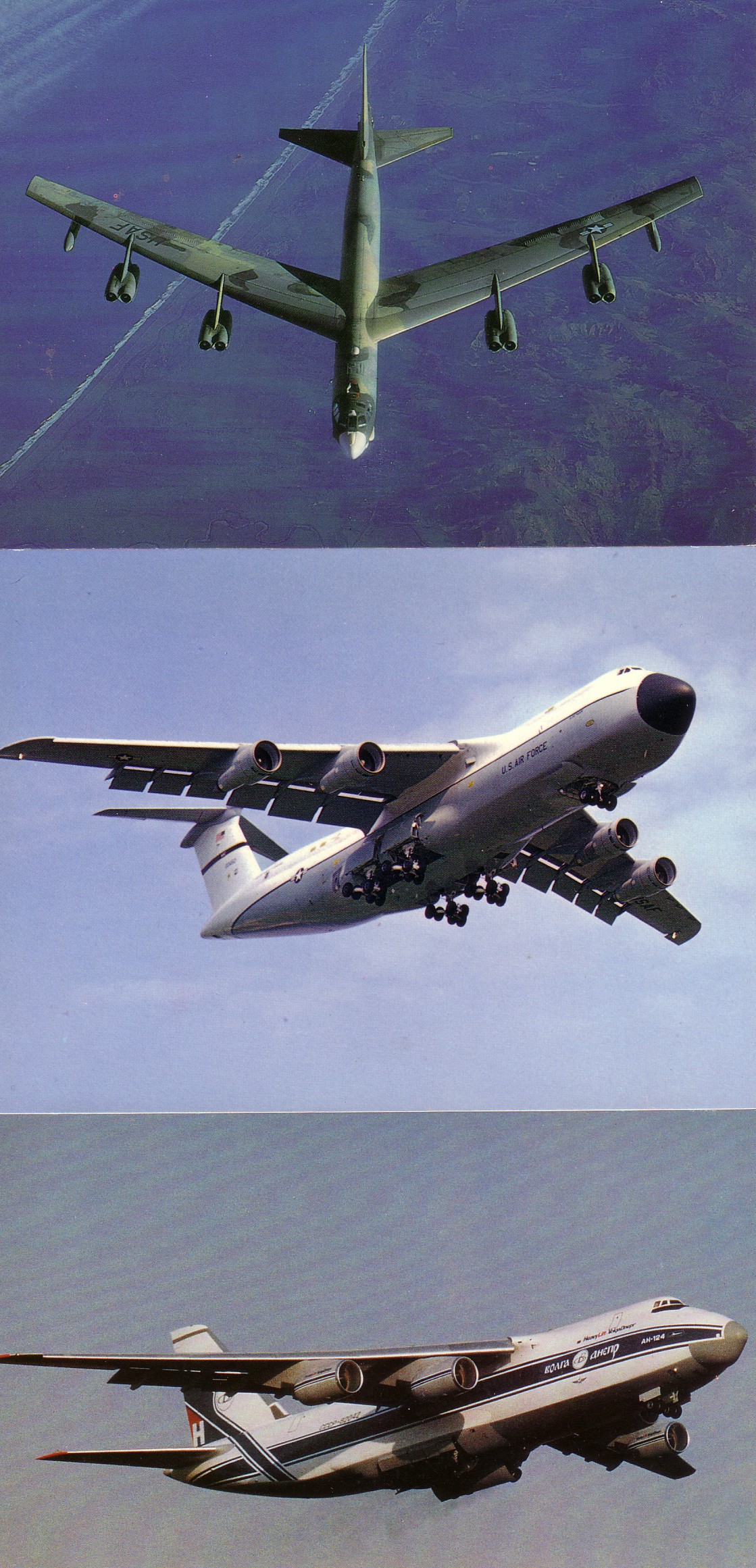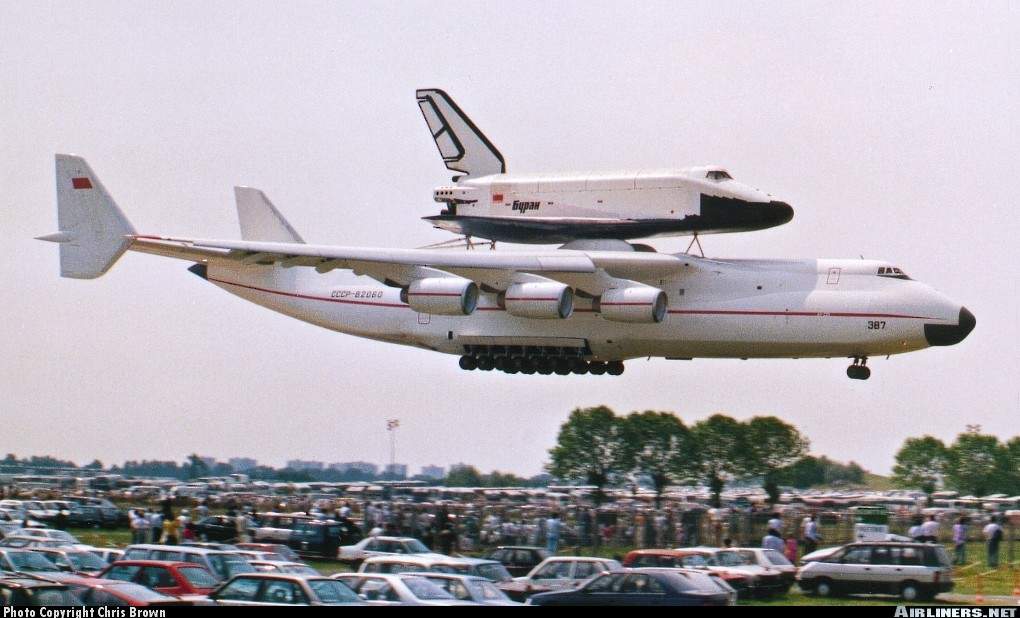
|
NEWSLETTER #56 - SEPTEMBER 2006
Members will have noticed that the US pages sometimes carry an earlier date than the main newsletter. This is because the US page is added to the main paper newsletter when it is circulated in the US in arrear of the UK edition, so it is actually published between UK paper editions.
Page 1 | Page 2
Although the long term trend in air transport has been that bigger = better, history is full of contrary examples of too big, too soon. It is possible that the A380 may be one of these, as the rise in fuel prices and concern about emissions may point to a return to fewer transocean flights between fewer destinations. But this may come too late and the B787 is cleaning up in the current market based on proliferation of city-pair services. Curiously Boeing went ahead with the 747, the one undoubted winner in gambling on size, because it had lost out 40 years earlier in undersizing the 247 against Douglas competitors.
If there is a start point for giant aeroplanes, (We will exclude airships , which have their own sizing rules) it is probably the Russian designs of Igor Sikorsky, pre WW1, notably the Ilya Mourometz. This was however little known outside Russia at the time. It featured 4 engines, an early example of this widely adopted configuration, and an outside “promenade deck” which was not imitated. The Russian Artist card in the next group of cards.
The oft used title “giant aircraft” was probably first used for the German multi-engine bombers of WW1. Publicly known as Gothas these were built by several companies including Zeppelin. The British response was the Handley Page series of multi-engined bombers culminating in the 4 engined V1500 intended to bomb Berlin. This had a take-off weight of 24,000 lbs. I will use weight as a measure of size, as span ceases to be comparable after the introduction of wing sweep.
Claimed to be the then worlds largest, the Siemens-Schuckert RVIII was the ultimate German bomber. It had 4 propellors driven remotely from 6 fuselage mounted engines and weighed in at 35,000 lbs . It never flew, being wrecked on the ground by a runaway propeller.
Use of metal construction tended to increase weights – the British built but German Rohrbach inspired 3 engined Beardmore Inflexible of 1928 weighed in at 37,000. Intended to be a transport, it was transferred to the RAF for trials on corrosion of metal structures. A wheel survives in a UK air museum.
The Lawson Airliner is on a card from a Milwaukee Museum. The Beardmore Inflexible is by Real Photographs Ltd
The card is one of many German issues
This is not from a postcard although several exist.
Only one of the double – deck passenger derivative the XC-99 was built. A civil version was 204 seats was proposed and formed the basis of the Pan American “Future Clipper” postcard set of the mid-1940s, which in many ways foresaw the 747. Stored out of service in a variety of locations, it has now been restored for the USAF museum in Dayton.
Early B-36 on Plastichrome P691 & a PanAm XC-99 based Future Clipper card
Estimates of what its all-up weight would have been vary from 300,00 to 400,000 lbs. The story of its disputed first flight and subsequent storage is well known. For a long time displayed with the Queen Mary at Long Beach it is now at McMinnville, near Portland OR. Many cards featured the Long Beach location but , for a change, here is the Hercules in its current location – this is a Web download, not a postcard.
French Brabazon photo card
Two retrospective Princess photo cards. 1952 launch in the BBC-Hulton plain back series & over Farnborough by Pamlin
Princess Artist Card by Banister for Salmon & Aeroflot Tu-114 issue
Turning back to the military, the B-36 had proved the viability of the large bomber, so it was natural that Boeing would plan for a “Jet B-36” as a development of their 6 jet B-47. The result was the 8 jet B-52 which first flew in 1952 and in developed versions, remains in USAF service today with the prospect of many more years to come. Developed versions weighed 488,000 lbs.
Experience of large aircraft led Boeing to consider a leap in size for its development of the 707 airliner. As they say, the rest is history with the Boeing 747 being by far the most successful launch of an aircraft whose size outstripped any equivalent in current service. The initial series weighed in at 710,000 lbs which has reached 870,000 lbs in the later Model 400 and will go further with the proposed -800. The -400 outweighs the Lockheed C-5 Galaxy military freighter which took the USAF contract which Boeing had thought might be the fall-back position if the airliner 747 was unsuccessful and which determined the high cockpit layout.
The Galaxy was in turn outweighed by the Soviet, now Ukrainian Antonov An-124 which now has something of a monopoly on civil airfreighting of very heavy or unusually shaped loads.
B-52G on After the battle P315, C-5 Galaxy by Baumann, Switzerland and An-124 in joint Heavylift/Volga-Dnieper colours – by Dennis for Heavylift.
This in turn gave rise to the Antonov 225 six-jet, designed originally to piggy-back the Soviet space shuttle but now, after a period in storage, back operating in the heavy freight charter market – it was actually in Manchester a few weeks back. At 1,322,000 lbs it outweighs the A.380 (1,235,000) and is currently the worlds largest aircraft. – non postcard picture below.
|
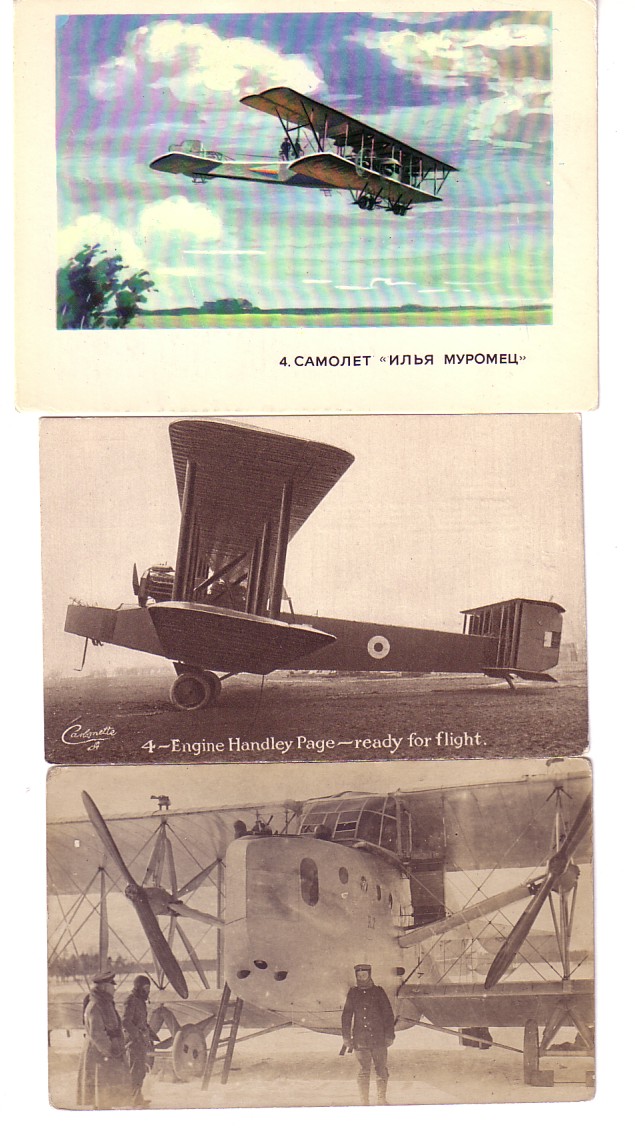 On these cards the HP V1500 is by Tuck. The back text says “This photograph gives an idea of the machine particularly the size of the fuselage” Its dimensions were Span 126 ft, length 52ft. The lower picture is an anonymous German card of the Siemens Schuckert RVII – predecessor of the RVIIII.
On these cards the HP V1500 is by Tuck. The back text says “This photograph gives an idea of the machine particularly the size of the fuselage” Its dimensions were Span 126 ft, length 52ft. The lower picture is an anonymous German card of the Siemens Schuckert RVII – predecessor of the RVIIII.
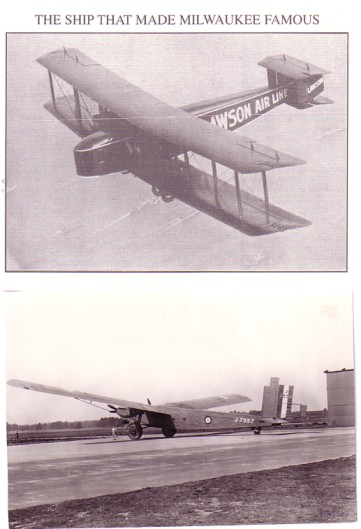 But in the US, the little known Lawson C-4 Airliner, built in Milwaukee in 1919 had a weight of 111,000 lbs and was supposed to carry 26 although only 14 seats were ever installed. The designer was Burnelli, later to develop flying-wing designs (see June issue). Lawson claimed he would have 100 flying transcontinental services centred on Chicago but the first flight with a full load proved the design to be underpowered. A three –engined larger development totally failed to become airborne .
But in the US, the little known Lawson C-4 Airliner, built in Milwaukee in 1919 had a weight of 111,000 lbs and was supposed to carry 26 although only 14 seats were ever installed. The designer was Burnelli, later to develop flying-wing designs (see June issue). Lawson claimed he would have 100 flying transcontinental services centred on Chicago but the first flight with a full load proved the design to be underpowered. A three –engined larger development totally failed to become airborne .
 However the first “Giant” to really make a public impact was the German Dornier Do.X 12 engined flying-boat of 1924. This was due to the combination of size, number of engines and the way it was used to promote the revival of the German aircraft industry after WW1, including well publicised, but not particularly successful atlantic flights. With 12 engines and an all up weight of 115,000 it was originally fitted with German built Bristol Jupiters but later replaced by Curtiss Conquerors. It was built on the Bodensee (Lake Constance) also the home of Zeppelins, but on the Swiss side due to post WW1 restrictions. It was never used in commercial service and was finally placed in a Berlin museum where it was destroyed by bombing. Two others were built for Italy but these also were not used commercially.
However the first “Giant” to really make a public impact was the German Dornier Do.X 12 engined flying-boat of 1924. This was due to the combination of size, number of engines and the way it was used to promote the revival of the German aircraft industry after WW1, including well publicised, but not particularly successful atlantic flights. With 12 engines and an all up weight of 115,000 it was originally fitted with German built Bristol Jupiters but later replaced by Curtiss Conquerors. It was built on the Bodensee (Lake Constance) also the home of Zeppelins, but on the Swiss side due to post WW1 restrictions. It was never used in commercial service and was finally placed in a Berlin museum where it was destroyed by bombing. Two others were built for Italy but these also were not used commercially.
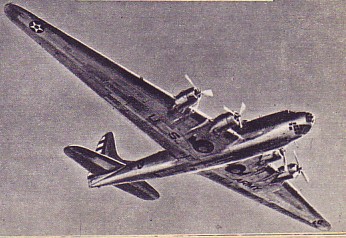 In the 1930s developments in speed overshadowed those in size. Some cards even describe the DC-3 as a “giant airliner”, even though the old Imperial Airways HP.42’s were larger. One odd fact is that the HP.42 s taken over by the RAF in 1940 became the widest span biplane ever used by the service. The DC-4E of 1938 was a relative giant at 65,000 lbs but the real Douglas giant of the time was the B-19 bomber at 140,000 lb. which should have flown in 1938 but actually did not complete until 1941, so delays are nothing new. By that time production had been concentrated on the B-17 and B-24 but the B-19 provided test data which went into the subsequent B-29 and B-36. It was finally scrapped at Davis-Monthan, Arizona in 1946.
In the 1930s developments in speed overshadowed those in size. Some cards even describe the DC-3 as a “giant airliner”, even though the old Imperial Airways HP.42’s were larger. One odd fact is that the HP.42 s taken over by the RAF in 1940 became the widest span biplane ever used by the service. The DC-4E of 1938 was a relative giant at 65,000 lbs but the real Douglas giant of the time was the B-19 bomber at 140,000 lb. which should have flown in 1938 but actually did not complete until 1941, so delays are nothing new. By that time production had been concentrated on the B-17 and B-24 but the B-19 provided test data which went into the subsequent B-29 and B-36. It was finally scrapped at Davis-Monthan, Arizona in 1946.
 The B-19 was superseded as the largest US aircraft by the Convair B-36 and its cargo equivalent the XC-99. The B-36 initially had 6 piston engines but later models added 4 jets. Weight was 370,000 lbs showing the order of magnitude technology advances arising from WW2. It was the first “giant” since the WW1 bombers to enter service in any numbers and was the mainstay of the US nuclear bomber force until the arrival of the all-jet B-47.
The B-19 was superseded as the largest US aircraft by the Convair B-36 and its cargo equivalent the XC-99. The B-36 initially had 6 piston engines but later models added 4 jets. Weight was 370,000 lbs showing the order of magnitude technology advances arising from WW2. It was the first “giant” since the WW1 bombers to enter service in any numbers and was the mainstay of the US nuclear bomber force until the arrival of the all-jet B-47.
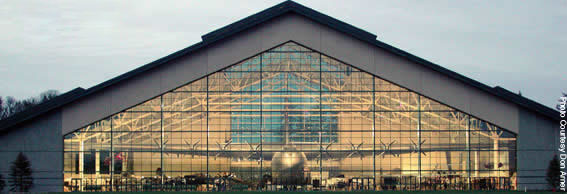 Moving from the B-19 to the B-36 ignores one of the most controversial giants, the 8 engined Hughes Hercules wooden flying boat. The title “spruce goose” was originally an insult.
Moving from the B-19 to the B-36 ignores one of the most controversial giants, the 8 engined Hughes Hercules wooden flying boat. The title “spruce goose” was originally an insult.
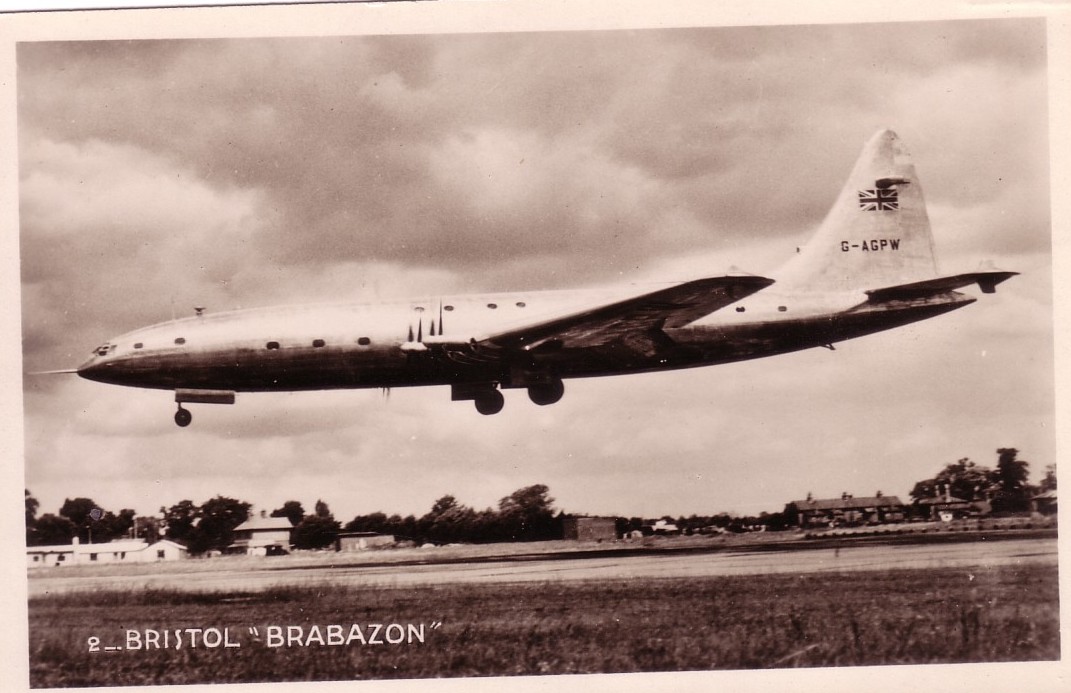 Post WW2, the cult of giant took firm hold in the UK with proposals for large landplane and flying boat designs which became the Bristol Brabazon and Saro Princess. The Brabazon had 8 engines driving 4 propellors in an arrangement which harked back to the Ww1 german giants. Centaurus props were fitted to the prototype but Proteus turbo-props were intended for the later Brabazon 2. In practice only the one was built. The hangar and runway at Filton built for the Brabazon later served for Britannia and Concorde assembly and flight. The Brabazon flew in 1949 and, at an all up weight of 290,000 lbs was the largest landplane ever built in the UK. Both prototypes were broken up in 1953.
Post WW2, the cult of giant took firm hold in the UK with proposals for large landplane and flying boat designs which became the Bristol Brabazon and Saro Princess. The Brabazon had 8 engines driving 4 propellors in an arrangement which harked back to the Ww1 german giants. Centaurus props were fitted to the prototype but Proteus turbo-props were intended for the later Brabazon 2. In practice only the one was built. The hangar and runway at Filton built for the Brabazon later served for Britannia and Concorde assembly and flight. The Brabazon flew in 1949 and, at an all up weight of 290,000 lbs was the largest landplane ever built in the UK. Both prototypes were broken up in 1953.
 The water based equivalent the Saro Princess did use the Proteus turboprop in a similar coupled configuration with 8 coupled engines and two singles. It did not fly until 1952 by which time BOAC had abandoned flying boat services. The three prototypes, only one of which flew were stored at Calshot until 1967. The second and third aircraft were cocooned before launch and towed direct from the slipway to Calshot. At 330,000 the Princess was the absolute largest ever UK built heavier than air aircraft.
The water based equivalent the Saro Princess did use the Proteus turboprop in a similar coupled configuration with 8 coupled engines and two singles. It did not fly until 1952 by which time BOAC had abandoned flying boat services. The three prototypes, only one of which flew were stored at Calshot until 1967. The second and third aircraft were cocooned before launch and towed direct from the slipway to Calshot. At 330,000 the Princess was the absolute largest ever UK built heavier than air aircraft.
 It was left to the Soviet Union to realise the concept of the giant turboprop with the Tupolev Tu-114 which entered service in 1961, 4 years after first flight. At 363,000 lbs it outweighed both the British designs and unlike them went into service on Aeroflot routes both transatlantic and transcontinental.
It was left to the Soviet Union to realise the concept of the giant turboprop with the Tupolev Tu-114 which entered service in 1961, 4 years after first flight. At 363,000 lbs it outweighed both the British designs and unlike them went into service on Aeroflot routes both transatlantic and transcontinental.
